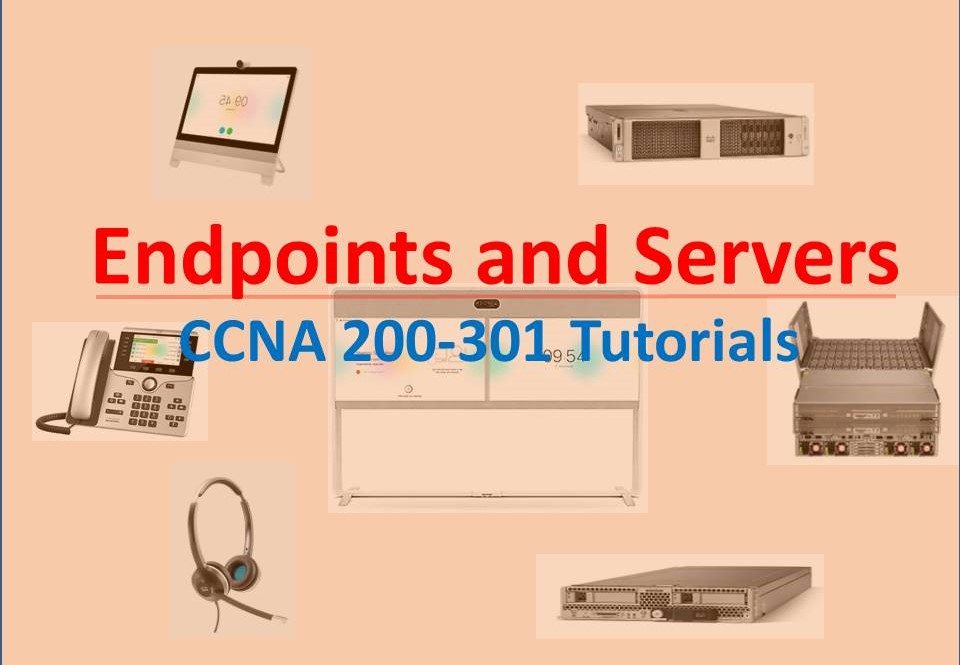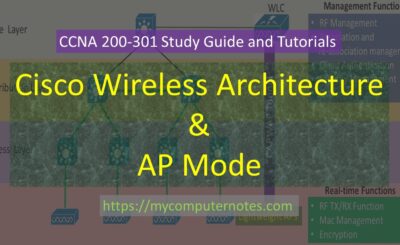In this section of CCNA 200-301 tutorials, we will discuss Cisco endpoints and servers. The endpoints are the devices that exist at the last end of the network, whereas the servers are the centralised devices that provide network resources to the clients or the hosts.
Endpoints and Servers
Endpoints
Endpoints are the end devices that sit on the edge of the network. They are the remote computing devices on the network that are connected to the mainstream network either through network switches or the router.
The user directly interacts with the network through the endpoint devices. Thus, endpoints may exist in different forms according to the users’ needs and applications. The endpoints may be in the form of laptops, workstations, desktops, IP cameras, IP phones, telepresence etc. Endpoints are designed to perform specific and limited functions.
What is Cisco Endpoint
Cisco provides a wide variety of endpoint devices known as Cisco endpoints that range from IP phones to web, mobile and desktop clients.
Business Phones
- IP phones
- IP phones with MPP firmware
- Webex wireless phones
Collaboration devices
- Cisco Webex Desk series
- Cisco Webex Desk board series
- Cisco Webex room series
Mobile endpoints
- Cisco Jabber
Cisco headset
- Cisco headset 500 series
- Cisco headset 700 series
Servers
A server can be dedicated hardware or in the form of software. The server as the name implies provides services to the client. In client-server network architecture, the server is a centralised device that provides resources to the client. The client requests services to the dedicated server, the server then provides services in response to the request made by the client.
Types of servers
The server may be deployed as a single unit or a cluster depending on the size of the network.
A small network with a limited number of clients can deploy a single unit of hardware to accommodate different server roles. However, for a large enterprise network where the number of clients is very large, a cluster of the server is deployed. Dedicated hardware is deployed
- Application server
- Database server
- DNS server
- File server
- Mail server
- Webserver
Application server
An application server is a type of server that can host different types of the application framework and provides services to the clients. Application server generally is referred to as middleware and resides between the database and the end-user. The application server captures data from the user and stores it in the database server.
Database server
A database server is a kind of server that manages a huge collection of complex databases. Specific database language such as SQL (Structured Query Language) is used for the insertion, creation, deletion and manipulation of user data.
DNS server
DNS stands for Domain Name System. DNS server translates the web address that we type in the browser to surf the internet into a numerical address called an IP address. In other words, the DNS server helps to resolve domain names into IP addresses and vice versa.
File server
A file server is a kind of server that stores and manages data files in the server and provides access to the other systems in a network. Keeping files in a centralized file server in a network environment avoids data duplicacy. It also simplifies the data backup and the restore operation.
Mail server
A mail server manages electronic mail or simply e-mail service centrally. A mail server manages a huge number of email clients and their mailboxes. The major protocols used by email servers are SMTP (Simple Mail Transfer Protocol), IMAP (Internet Message Access Protocol) and POP3 (Post Office Protocol-3). SMTP is used to send the email, whereas the IMAP and POP3 are sued to receive the mail
Web server
a web server may be in the form of dedicated hardware or the application software that responds to the HTTP requests from the client and display the HTML content to the client machine in a readable format. HTTP is a hypertext transfer protocol that connects the webserver with the remote client over the world wide web.
Cisco Servers
Cisco servers come with a wide variety of high-end servers with different form factors to meet companies business needs.
UCS B-Series Blade Servers
- UCS B200 M5 Blade Server
- UCS B480 M5 Blade Server
- UCS Mini
- UCS 5100 Series Blade Server Chassis
UCS C-Series Rack Servers
- UCS C125 M5 Rack Server
- UCS C220 M5 Rack Server
- UCS C240 M5 Rack Server
- UCS C240 SD M5 Rack Server
- UCS C480 M5 Rack Server
- UCS C480 ML M5 Rack Server
- Cisco UCS C4200 Series Rack Server Chassis
UCS S-Series Storage Servers
- S3260 M5 Storage Server
| ←Prev | Next→ | |
| Cisco DNA Centers and WLC | Cisco Network Topology Architecture |






